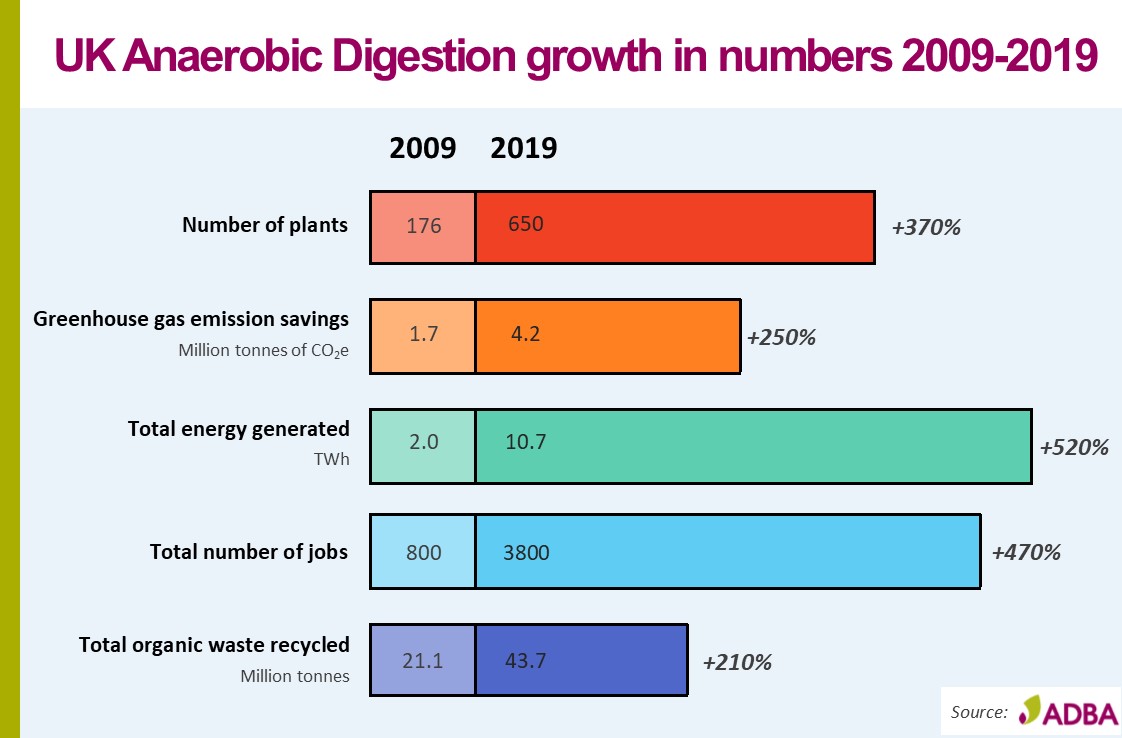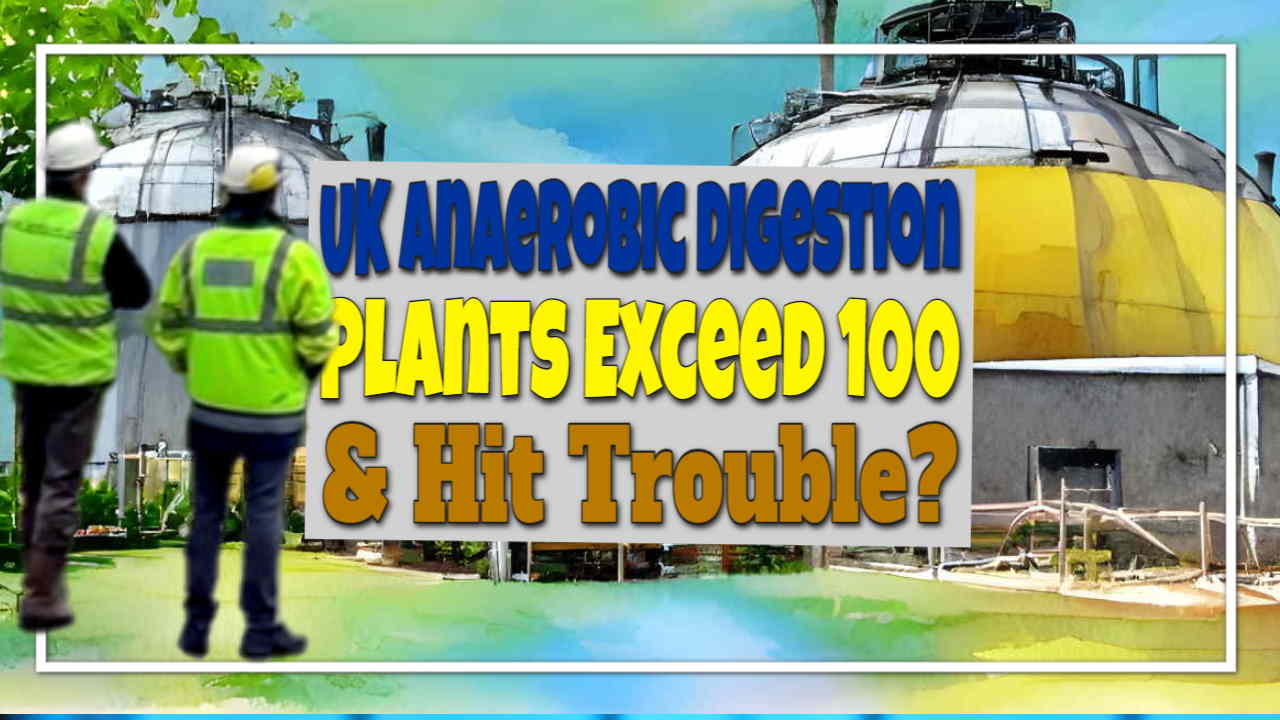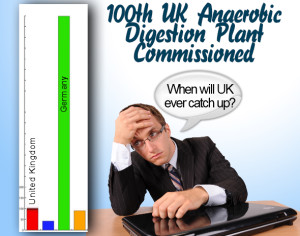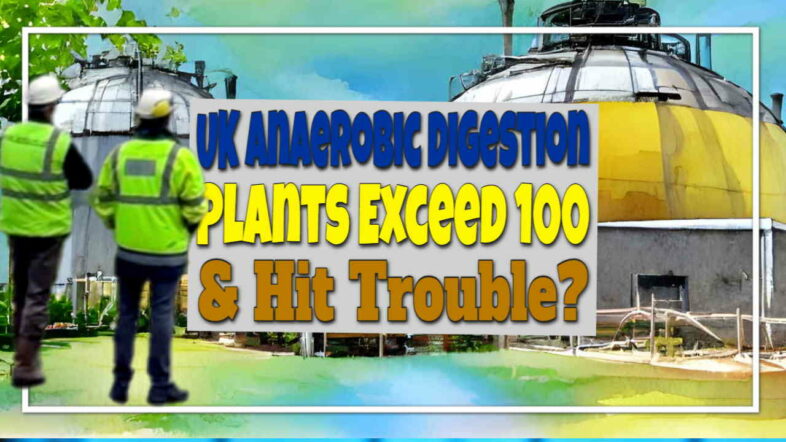In this article, we will look back at our March 2013 article when UK Anaerobic Digestion Plants exceeded 100 and were receiving damaging media attention due to novice operators causing some high-profile environmental problems. So, we reported that they were “hitting trouble”.
The fact is that now (in 2023), with the benefit of hindsight, we can see that we were wrong. There are now over 600 operating biogas plants in the UK!
Yes, of course, there have been teething problems with new biogas plant owners. Some, for example, started out while not appreciating the harm biogas tank leaks can cause. But we argue that they have been quick to learn not to pollute, and the record of the AD industry on this is now much better.
The growth of AD since that day in 2013 when we marvelled at the first 100 AD installations, there has been an amazing over 6-fold increase, to 650 today (2019) as shown by our graphic image below:

What has also become evident since is that there is a much larger quantity of biomass which will become available as the UK moves into being a “circular economy”.
The UK will not be following Germany where although they have several thousands of biogas plants, most use maize crops.
Nowadays, the use of food crops to make energy is frowned upon, as it could conceivably raise food prices in a competitive market for UK Anaerobic Digestion Plants.
But it matters not! Food crops are not needed if the feed source comes from waste. and, that's where the new biogas facilities will get the “energy food” known as “digester feedstock” from.

A 101 on Biogas Plants and the Potential of the UK Anaerobic Digestion Plants to be a Bad Neighbour
Biogas plants are facilities that generate biogas from organic materials such as agricultural waste, food waste, and sewage sludge via anaerobic digestion. These plants can cause a variety of pollutants, including:
Air pollution
Biogas plants can produce gases that are detrimental to human health and the environment, such as methane, carbon dioxide, and nitrogen oxide. If the biogas facility is located in a densely populated area, air pollution may be an issue.
Water pollution
Biogas plants also create digestate, a liquid waste with high quantities of nutrients and organic debris. This digestate, if not adequately handled, can contaminate surrounding water sources, producing eutrophication, algal blooms, and fish mortality.
Noise pollution
Biogas plants can be noisy, especially when machinery such as pumps and agitators are in use. This noise may annoy surrounding neighbours as well as wildlife.
Odour pollution
Biogas plants can create offensive odours, especially while handling and processing organic materials. This can be a major annoyance to local residents and businesses.
UK Anaerobic Digestion Plants Hit Trouble Take-Aways
It should be noted that all biogas facilities in the United Kingdom are subject to tight rules and monitoring by the Environment Agency (EA) in order to minimise their impact on the environment and human health. The EA would examine any pollution incidents and, if necessary, take appropriate legal action.
The vast majority of biogas plants are well-run. They do not pollute and are good neighbours to those who live near them.
The original March 2013 article follows:
UK AD Plants Exceed 100 And Hit Trouble
The good news for UK Anaerobic Digestion Plants is that the magic number of 100 anaerobic digestion plants in the UK has now been exceeded.
In fact, if you visit the AD Info “Official Anaerobic Digestion” website, you will find that their list of 100 does not include a number of categories of AD plants, such as Water Company sewage sludge-fed plants. That means that the true number is probably more like 125 already, plus even within their categories we know of several unlisted digesters.
 Even so, the UK is still a long way behind Germany and other EU states, so we maybe should not be proclaiming this achievement at all? On balance, I think the UK is right to give itself a small pat on the back. But, let's not forget that Germany has two to three thousand AD Plants in operation. Yes. That is thousands!
Even so, the UK is still a long way behind Germany and other EU states, so we maybe should not be proclaiming this achievement at all? On balance, I think the UK is right to give itself a small pat on the back. But, let's not forget that Germany has two to three thousand AD Plants in operation. Yes. That is thousands!
And yet, the proportion of UK Anaerobic Digestion Plants that are organic waste fed, as opposed to energy crops, is vastly higher than in Germany, and that in itself is arguably far better. It is better for the environment and the avoidance of potentially reducing food production and raising food prices. So, the UK AD industry is correspondingly much “greener”.
The following is the press release that prompted this article:
UK Anaerobic Digestion Plants Hit the 100 Mark…
“The number of anaerobic digestion (AD) plants in the UK – excluding waste water plants – has passed the 100 mark. via www.mrw.co.uk-news
But, unfortunately, as the UK biogas industry is expanding it is also beginning to hit trouble with odours and pollution. The Poplars Landfill Anaerobic Digestion Plant was last week in the News for continued odour complaints from local residents. Hopefully, that will be a thing of the past, after the plant operator brings in new measures to combat those odours this month.
Watercourse pollution is the “trouble” that one AD Plant operator has been “hit” by. Yet, one wonders whether the method being used for pumping the digestate at the time was wise, given the risk of pollution.
The following is an extract from the article, to which we refer:
Somerset company fined for polluting stream with waste from anaerobic digester…
Waste Management World
“The pipe had broken free while digestate was being pumped from the anaerobic digestion plant. The pollution flowed into a trench and eventually into a stream which flows into the River Parrett. Approximately 60 tonnes of liquid digestate was lost …” via Somerset_Fine
The River Parrett is slow-flowing through the Somerset levels so the potential damage to river ecology is large.
[First published: March 2013. Updated 18 November 2019 and 24 March 2023.]





Only natural products, goods, services, and materials should be licenced by the government, keeping the environment and pandemic scenario in mind.